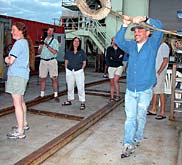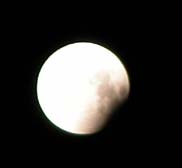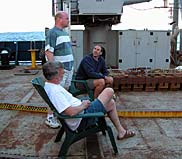|
|
|
|
|
|
|
|
|
| Sun |
Mon |
Tue |
Wed |
Thu |
Fri |
Sat |
|
|
 |
|
Q. How does the Atlantis stay in one place? (From Kaytie, Screven County Elementary School, Sylvania, GA)
A. There are a couple different ways that the ship stays in one place. The first is that the bridge (the place where all the controls are to drive the ship) is manned 24 hours a day--there are always two people on the bridge at any one time. It is the tallest part of the ship and has many windows so that people have a very wide angle view of the ocean around them. This is so they can see passing ships, things that might be floating in the water (like logs) that could damage the boat, and commonly, they are the first to spot whales or dolphins that come to visit us.
The crew "manning the bridge" can manually drive the boat in any direction they choose. Sort of like driving a car. When Alvin is in the water, the ship stays in roughly the same spot, but they do not hold it very tight on station...meaning that it can drift 100's of feet and that is ok. If it starts drifting too far, the crew can give extra power to engines that drive large propellers in the hull of the ship and this allows them to drive the boat in any direction at the speed they choose. However, sometimes we need the ship to stay in an exact spot and not drift more than a few feet. In this case, the driving of the ship is taken over by computers. The crew types in the exact location that we need the ship to hold station at, and then the computers take over telling the propellers what to do, how fast to turn, and in what direction. They do this by a very sophisticated system.
The ship has a system that can communicate with satellites that fly overhead. By communicating with multiple satellites at one time, the position of the ship can be determined very accurately. This satellite system is called GPS for short, or the Global Positioning System. The computers onboard continually communicate with the satellites and update the position of the ship constantly. This information is processed by the computers and the computers adjust the engines and propellers to keep the ship in one place. This method of driving the ship is called Dynamic Positioning.
|
 |
|
 |
|
|
|
|
|
 |
Now that the Alvin, CTD, and ABE operations are over for this cruise and we’re in transit to Bermuda, you might think we’re lounging around watching movies, sunning on the deck, and playing lots of ping pong. Larry and Linda did provide a delicious barbeque for us on the fantail last night, but mostly, we’ve spent the past couple of days preparing preliminary results for the “cruise report.” The computer lab has been crowded (and a bit crazy) recently as people jockey for the CD player and their favorite computers as we all try to pull together our reports by the deadline. We just had a science meeting where each group tried to summarize in ten minutes or less everything they’ve learned in this one short month. It’s pretty impressive, and it reminded me how lucky I am to be working with so many smart, capable people on such an exciting project.
 |
|
People hang out on the fantail during the BBQ.
|
When we get back home, I’ll be studying the geology of the Lost City and the Atlantis Massif. My first task will probably be to create a detailed structural map of the field. ABE has provided us with an incredible bathymetric map of the area to use as a base, and the Alvin dives have provided great images, observations, and samples. Using this data, I can map the faults, joints, rock types, deformation zones, and vents in this area, giving us a better idea of how the Lost City formed and how the fluids find pathways to travel through the rock. One of the things I’ll do is put together some of the images into larger “photomosaics” to get a larger-scale view of the geology. In addition to the many hours of videotape, the Alvin dives generated about 60,000 individual images of the area, so I ought to have plenty of material to work with!
 |
|
The lunar eclipse comes to an end, and the tired people who stayed up deep into the night could finally go to sleep.
|
Even though the lunar eclipse was a few days ago, this is my first time writing since then, so I want to say a few words about it, since I hear that many of you were clouded in and didn’t have the pleasure of watching it. The science party started appearing on deck around midnight, sprawling on the deck on beach towels, eating popcorn, chatting. The clouds were beautiful under the full moon – the puffy tops shining, isolated patches of the ocean sparkling. We saw the beginning of the eclipse, with the lower left corner of the moon just bent out of shape, then a big cloud covered it for about ten minutes, leaving us wondering if we would get cheated out of the show. But the clouds broke, and we had a clear view as it went to full eclipse, when it glowed a gorgeous dusky orange. But the best part was the stars – without the orange glow from New York or Durham or Seattle to drown them out. A few of us aren’t used to being able to see the Milky Way; luckily, there were others to set us straight. We even got a couple of shooting stars to make us feel we got our money’s worth!
 |
|
Eric, Tim, and Phil take a break on the fantail.
|
However, the scene was perhaps not as romantic as those who’ve never been to sea before might imagine. A ship is a very noisy place – the engines are very loud and there are always lights on and unidentified chemical smells in the air. But, still, this was an amazing place to watch the eclipse. And last night, another treat: green bioluminescent specks in the foam streaking past the side of the ship. Tomorrow we’ll be packing – everything from lab equipment to rock and water samples to office supplies goes in buckets and crates. But we’re all excited to be headed for shore – only two more days to Bermuda. A couple of days offloading in port, then home (for most of us), back to where the floors are stationary, wallets and keys are necessary, and the days of the week have meaning.




